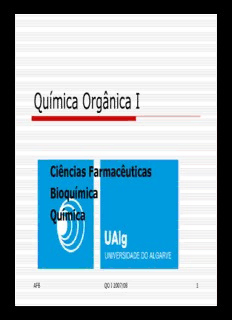
p PDF
Preview p
Química Orgânica I Ciências Farmacêuticas Bioquímica Química AFB QO I 2007/08 1 alcohols (cid:1) Adaptado de (cid:2) Organic Chemistry, 6th Edition; Wade (cid:2) Organic Chemistry, 6th Edition; McMurry AFB QO I 2007/08 2 Typical reactions of alcohols (cid:1) Two general classes of reaction (cid:2) At the carbon of the C–O bond (cid:2) At the proton of the O–H bond AFB QO I 2007/08 3 Types of Alcohol Reactions (cid:1) Dehydration to alkene (cid:1) Oxidation to aldehyde, ketone (cid:1) Substitution to form alkyl halide (cid:1) Reduction to alkane (cid:1) Esterification (cid:1) Tosylation (cid:1) Williamson synthesis of ether => AFB QO I 2007/08 4 Summary Table => AFB QO I 2007/08 5 Oxidation States (cid:1) Easy for inorganic salts (cid:2) CrO 2- reduced to Cr O 4 2 3 (cid:2) KMnO reduced to MnO 4 2 (cid:1) Oxidation: loss of H , gain of O, O , or X 2 2 2 (cid:1) Reduction: gain of H or H-, loss of O, O , or 2 2 X 2 (cid:1) Neither: gain or loss of H+, H O, HX 2 => AFB QO I 2007/08 6 Oxydation (cid:1) 1º Carbons (cid:1) 2º Carbons (cid:1) 3º Carbons => AFB QO I 2007/08 7 Oxidation of 1° Alcohols (cid:1) 1° alcohol to aldehyde to carboxylic acid (cid:1) Difficult to stop at aldehyde (cid:1) Use pyridinium chlorochromate (PCC) to limit the oxidation. (cid:1) PCC can also be used to oxidize 2° alcohols to ketones. OH N H CrO3Cl O CH CH CH CH CH CH CH CH 3 2 2 2 3 2 2 => AFB QO I 2007/08 8 Oxidation of 2° Alcohols (cid:1) 2° alcohol becomes a ketone (cid:1) Reagent is Na Cr O /H SO 2 2 7 2 4 (cid:1) Active reagent probably H CrO 2 4 (cid:1) Color change: orange to greenish- blue OH O Na Cr O / H SO 2 2 7 2 4 CH CHCH CH CH CCH CH 3 2 3 3 2 3 => AFB QO I 2007/08 9 Mechanism of Chromic Acid Oxidation (cid:1) Alcohol forms a chromate ester followed by elimination with electron transfer to give ketone AFB QO I 2007/08 10
Description: